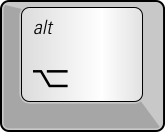Option key
 | |
| Names | Option |
|---|---|
| Mac symbol |
⌥ |
The option key (abbreviated opt) is a modifier key on Macintosh keyboards used for modifying commands and actions, for caret navigation, and for providing extended character entry.
Some option keys also have the text "alt". It was introduced in 1987 on the Apple Extended Keyboard for ease of use with expansion cards or emulators for running MS-DOS. The last additional legends were removed in 2017 with a revision of the Apple Magic Keyboard. The key still works as an Alt key when connected to a PC, and vice versa.
Command modifier
The option key can be included in keyboard shortcuts to modify the nature of the command. OS X introduced a feature where menu items change from their normal to their alternate state on the fly when the option key is pressed and released while the menu is open.
Action modifier
The option key can be held when performing an action, for example to switch a mouse drag from a move to a copy. In this sense, it functions similarly to the shift and control keys in Microsoft Windows.
Opt+left and opt+right move the caret one word to the left and right, and opt+up and opt+down move the caret one page up and down respectively. By comparison, the home, end, page up and page down keys scroll the viewport as though the user had operated the scroll bar, without moving the caret. This distinction does not exist in Windows.
Extended character entry

The option key provides two additional logical input layers. These layers provide both direct symbol entry and dead key entry. For example, on a MacRoman layout, opt-T generates "†", and opt-U (umlaut dead key) followed by O produces "ö". Microsoft Word provides a similar facility, but this has always been a system-wide feature on the Macintosh. The compose key provides related functionality on other systems.
The Matias Tactile Pro and Quiet Pro are the only known Macintosh keyboards to inscribe the option layers directly onto the keycaps for reference.